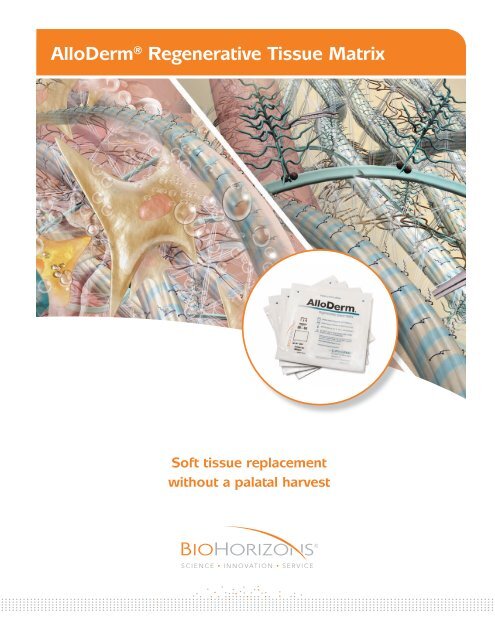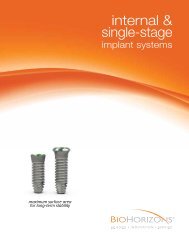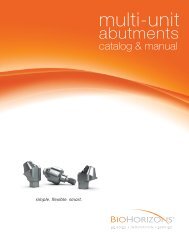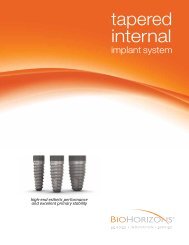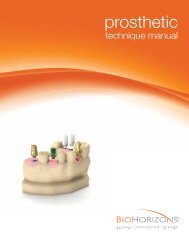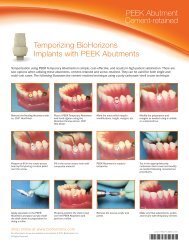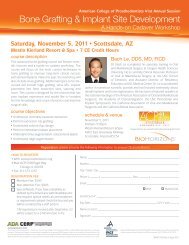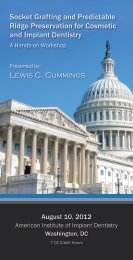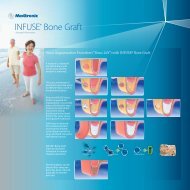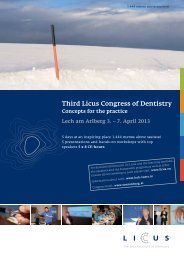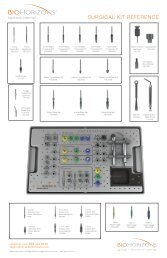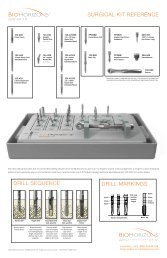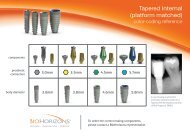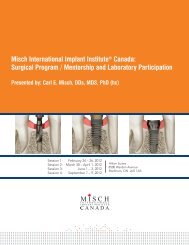AlloDerm® Regenerative Tissue Matrix - BioHorizons
AlloDerm® Regenerative Tissue Matrix - BioHorizons
AlloDerm® Regenerative Tissue Matrix - BioHorizons
Create successful ePaper yourself
Turn your PDF publications into a flip-book with our unique Google optimized e-Paper software.
AlloDerm® <strong>Regenerative</strong> <strong>Tissue</strong> <strong>Matrix</strong>Soft tissue replacementwithout a palatal harvest
AlloDermWhat is AlloDerm <strong>Regenerative</strong> <strong>Tissue</strong> <strong>Matrix</strong>?AlloDerm is an acellular dermal matrix derived from donated humanskin that undergoes a multi-step proprietary process that removes boththe epidermis and the cells that can lead to tissue rejection. AlloDerm has beenused in a wide variety of soft tissue grafting procedures such as root coverage, softtissue augmentation and guided bone regeneration with a consistent record of excellent results. 1-7AlloDerm offers numerous advantages compared to the connective tissue autograft from the patient’s palate:• Eliminates the need for palatal surgery• Removes palatal harvesting limitations from treatment planning considerations• Reduces patient reluctance to follow through with surgical treatment• Consistent quality• Provided in multiple convenient sizes• Available in two thickness ranges for use in different procedures:0.9 to 1.6 mm - AlloDerm for root coverage, soft tissue ridge augmentation, etc.0.5 to 0.8 mm - AlloDerm GBR for guided bone regeneration and barrier membrane functionProcurement and safetyAlloDerm has a safety history of more than a decade. Introduced in 1994 for treating burn patients, AlloDerm has proved itsversatility and safety in more than a million diverse procedures in general, orthopedic, urogenital, and dental surgeries. 8AlloDerm owes its exemplary safety to the safeguards at every step starting from donor screening to the final packaging.• <strong>Tissue</strong> accepted only from AATB (American Association of <strong>Tissue</strong> Banks) compliant tissue banks• Extensive panel of serology tests• Proprietary processing technology removes immunogenic cells and minimizes risk of disease transmission• Final sterility testing ensures that no external pathogens are introduced while processing
<strong>Regenerative</strong> <strong>Tissue</strong> <strong>Matrix</strong>Processing of AlloDermThe proprietary processing to derive AlloDerm from donor tissue involves a series of steps:• Treatment with buffered salt solution to separate and eliminate the epidermis• Series of washes with mild non-denaturing detergent solutions to solubilize and eliminate all cells• Final freeze drying step using patented technology that prevents damaging ice crystal formationAllograft <strong>Tissue</strong>Removal of epidermis and cells<strong>Regenerative</strong> <strong>Tissue</strong> <strong>Matrix</strong>Complex acellular heterogenous scaffold, withgrowth factor binding sites and blood vesselarchitecture; dehydrated and ready to implantHow does AlloDerm work?AlloDerm provides a matrix consisting of collagens, elastin, vascular channels, and proteins that support revascularization, cellrepopulation and tissue remodeling.After placement, the patient’s blood infiltrates the AlloDerm graft through retained vascular channels, bringing host cells that adhereto proteins in the matrix. Significant revascularization can begin as early as one week after implantation. The host cells respondto the local environment and the matrix is remodeled into the patient’s own tissue, in a fashion similar to the body’s natural tissueattrition and replacement process.Because the components remain in theirnatural biologically active state, ADM isimmediately recognized as human tissue.Rapid cell repopulation and revascularization.Initiation of intrinsic regeneration process.Complete remodeling into the patient’s own tissue.Functional, physiological and reconstructive outcomes.
AlloDermDocumented equivalence to autogenous connective tissueMultiple, randomized clinical trials (RCT) have shown root coverage results with AlloDerm to be equivalent to autogenous connectivetissue, and concluded that the procedure was predictable and practical. A meta-analysis of eight RCTs showed no statisticallysignificant differences between the two groups for measured outcomes: recession coverage, keratinized tissue formation, probingdepth and clinical attachment levels. 9Keys for successful root coverage include:• Thorough root conditioning and/or restoration removal• Flap or Pouch design that minimizes loss of vascularity• Tension-free coronal positioning of flap or pouch to completely cover AlloDermHistological evidence of remodellingA human histologic evaluation of AlloDerm and connective tissue (CT) documented that both formed a band of dense collagenoustissue when placed beneath a coronally advanced flap. Gingival attachment, a combination of long junctional epithelium andconnective tissue adhesion, was comparable for both groups. At six months postoperatively, the overall histologic outcomes weresimilar for both CT and AlloDerm grafts. 10Connective tissue specimendemonstrating mucosaltissue (M) overlying densegrafted connective tissue(C) and osseous crest (B).Original magnification40X; hematoxylin and eosin(H&E) staining.Acellular dermal matrix specimendemonstrating mucosal tissue(M) overlying the area of graftplacement (ADM) and osseouscrest (B). Original magnification40X. Verhoff solution stainedelastin fibers help differentiategraft area from host tissue.Cummings et al. Histologic Evaluation of Autogenous Connective <strong>Tissue</strong> and Acellular Dermal <strong>Matrix</strong> Grafts in Humans. J Periodontol 2005;76:178-186.Ease of useRemove from pouch• AlloDerm has up to a 2-year shelf-life whenstored between 1°-10°C (34°-50°F).• Open outer foil pack. Drop graft into salinebath directly from inner pouch.Rehydrate• Rehydrate in two consecutive sterilesaline baths.• Remove paper backing from AlloDermbetween first and second baths.Two distinct surfaces• Basement membrane side (BM) is roughand will not readily absorb blood.• Dermal side is smooth and will absorbblood.Important: Before use, clinicians should review all risk information and directions, which can be foundon the packaging and in the “Information for Use” attached to the packaging of each AlloDerm graft.
<strong>Regenerative</strong> <strong>Tissue</strong> <strong>Matrix</strong>Root CoverageAlloDerm is ideal for treating multiple defects in a single procedure. Available sizes include: 1cm x 1cm, 1cm x 2cm, 1cm x 4cm and2cm x 4cm. After hydration it may be trimmed to the desired size with a scalpel or sharp scissors.Photos courtesy of Dr. Edward P. Allen, Dallas, TexasGingival recession with root surfacerestorations.AlloDerm graft placed in pouchand sutured.Complete root coverage at one yearpostoperatively.Soft <strong>Tissue</strong> Ridge AugmentationAlloDerm can be used effectively for soft tissue ridge augmentation. A tunnel or pouch may be created beneath the defect intowhich the AlloDerm can be inserted. If multiple layers of AlloDerm are used for increased thickness, it is recommended that it belayered, rather than rolled. In this indication, orient the dermal surfaces on the outside of the graft.Photos courtesy of Dr. Edward P. Allen, Dallas, TexasAlveolar ridge deficiency at siteof missing maxillary left lateralincisor and canine.Folded and sutured AlloDerm graftplaced and sutured within the softtissue pouch.3 months post-op showingrestoration of normal alveolarridge contour.Soft <strong>Tissue</strong> Augmentation Around Dental ImplantsAlloDerm is effective in augmenting thin tissue around dental implants to create more attached tissue.Photos courtesy of Dr. Carl E. Misch, Beverly Hills, MichiganTreatment plan for revision of a failing2-implant overdenture to a 5-unitcemented bar overdenture.The bony defect is grafted usingautologous bone from osteotomies.The AlloDerm is oriented withbasement membrane up.Postoperative results show thick,immobile tissue.
AlloDermA biological barrier for better hard and soft tissue regenerationUnlike other barrier membranes that either resorb too quickly or do notresorb at all, AlloDerm GBR actually allows the body to remodel it intothe patient’s own tissue. This results in good bone regeneration whilebenefiting soft tissue quality and esthetics. 11-12AlloDerm GBR, unlike conventional barrier membranes, if left exposedbecause of incomplete primary closure, has a significantly reduced chance of infection and graft failure due to rapid revascularization.A recent study demonstrated that sites covered with AlloDerm generated 16% more vital bone in extraction sockets than did sitescovered with an ePTFE membrane. 13A separate study concluded that AlloDerm, used as a barrier over resorbable hydroxyapatite in extraction sites, was able to preserveridge dimensions and significantly increase the width of keratinized tissue. 14Guided Bone RegenerationAlloDerm GBR is produced by exactly the same process as AlloDerm, but it is thinner (0.5 to 0.9mm) which facilitates primaryclosure. It readily adapts to graft sites and can be secured with either sutures or tacks.Extraction sites grafted withGrafton® DBM.AlloDerm GBR covering the ridgebeneath the flap to obtain tensionfreeclosure.Post-operative result showsexcellent soft tissue coverage.Sizes availableOnlyAlloDermGBR2cm x 4cm2cm x 2cm1cm x 4cm1cm x 2cm1cm x 1cmAlloDerm and AlloDerm GBR are available in these convenient sizes. Examples are shown to scale.
<strong>Regenerative</strong> <strong>Tissue</strong> <strong>Matrix</strong>References1. Management of Gingival Recession by the Use of a Acellular Dermal Graft Material: A 12-Case Series. Santos A, GoumenosG and Pascual A. J Periodontal 2005;76(11):1982-1990.2. Subpedicle Acellular Dermal <strong>Matrix</strong> Graft and Autogenous Connective <strong>Tissue</strong> Graft in the Treatment of Gingival Recessions:A Comparative 1-Year Clinical Study. Paolantonio M, Dolci M, Esposito P, D’Archivio D, Lisanti L, Di Luccio A and Perinetti G. JPeriodontol 2002;73(11):1299-1307.3. Clinical Evaluation of Acellular Allograft Dermis for the Treatment of Human Gingival Recession. Aichelmann-Reidy ME,Yukna RA, Evans GH, Nasr HF and Mayer ET. J Periodontol 2001;72(8):998-1005.4. Predictable Multiple Site Root Coverage Using an Acellular Dermal <strong>Matrix</strong> Allograft. Henderson RD, Greenwell H, Drisko C,Regennitter FJ, Lamb JW, Mehlbauer MJ, Goldsmith LJ and Rebitski G. J Periodontol 2001;72(5):571-582.5. Surgical therapies for the treatment of gingival recession. A systematic review. Oates TW, Robinson M and Gunsolley JC.Ann Periodontol 2003;8:303-320.6. Root coverage of advanced gingival recession: A comparative study between acellular dermal matrix allograft andsubepithelial connective tissue grafts. Tal H, Moses O, Zohar R, et al. J Periodontol 2002;73:1405-1411.7. The clinical effect of acellular dermal matrix on gingival thickness and root coverage compared to coronally positioned flapalone. Woodyard JG, Greenwell H, Hill M, et al. J Periodontol 2004;75:44-56.8. Data on file.9. Acellular Dermal <strong>Matrix</strong> for Mucogingival Surgery: A Meta-Analysis. Gapski R, Parks CA and Wang HL. J Periodontol2005;76(11):1814-1822.10. Histologic Evaluation of Autogenous Connective <strong>Tissue</strong> and Acellular Dermal <strong>Matrix</strong> Grafts in Humans. Cummings LC,Kaldahl WB and Allen EP. J Periodontol 2005;76(2):178-186.11. Acellular Dermal <strong>Matrix</strong> Graft as a Membrane for Guided Bone Regeneration: A Case Report. Novaes AB Jr and Souza SL.Implant Dentistry 2001;10(3):192-195.12. Ridge Preservation Utilizing an Acellular Dermal Allograft and Demineralized Freeze-Dried Bone Allograft: Part I. A Reportof 2 Cases. Fowler EB, Breault LG and Rebitski G. J Periodontol 2000;71(8):1353-1359.13. Extraction Sockets and Implantation of Hydroxyapatites With Membrane Barriers, A Histologic Study. Froum S, Cho SC,Elian N, Rosenberg E, Rohrer M and Tarnow D. Implant Dentistry 2004;13(2):153-164.14. Acellular Dermal <strong>Matrix</strong> and Hydroxyapatite in Prevention of Ridge Deformities after Tooth Extraction. Luczyszyn SM,Papalexiou V, Novaes AB Jr, Grisi MF, Souza SL and Taba M Jr. Implant Dent 2005;14(2):176-184.Grafton® DBM and MinerOss® are processed by:AlloDerm® and AlloDerm® GBR are processed by:
<strong>BioHorizons</strong> USA2300 Riverchase CenterBirmingham, AL 35244Customer Care / Servicio al Cliente:888-246-8338 or 205-967-7880<strong>BioHorizons</strong> Canada21 Amber Street, Unit # 6Markham, Ontario L3R 4Z3Customer Care / Service à la Clientèle:866-468-8338 or / ou 905-944-1700<strong>BioHorizons</strong> SpainSerrano Anguita, 1028004 Madrid, EspañaAtención al Cliente:+34 91 713 10 84<strong>BioHorizons</strong> UK17 Wellington Business ParkDukes RideCrowthorne, Berkshire RG45 6LSCustomer Care:+44 1344 752560<strong>BioHorizons</strong> GermanyMarktplatz 379199 KirchzartenKunden Service:+49 7661-909989-0<strong>BioHorizons</strong> Australia25-33 Allen StreetWaterloo NSW 2012Customer Care:+61 2 8399 1520<strong>BioHorizons</strong> MexicoKelvin 8 Dept. 303Col. AnzuresC.P. 11590, Mexico, D.F.Servicio al Cliente:+52 55 5545 1297<strong>BioHorizons</strong> ChileCerro Colorado 5030, Officina 513Las CondesSantiago, ChileAtención al Cliente:+56 2 361 9519As applicable, <strong>BioHorizons</strong> products are cleared for sale in the European Union under the EU Medical Device Directive 93/42/EEC. We areproud to be registered to ISO 13485:2003, the international quality management system standard for medical devices, which supports andmaintains our product licences with Health Canada and in other markets around the globe.Not all products are available in all markets. AlloDerm® and AlloDerm® GBR must be shipped overnight and maynot be returned or exchanged for credit due to specific guidelines regarding the storage of allograft tissue.© 2008 <strong>BioHorizons</strong> Implant Systems, Inc. All Rights Reserved. MLD102 REV A NOV 2008w w w . b i o h o r i z o n s . c o m


